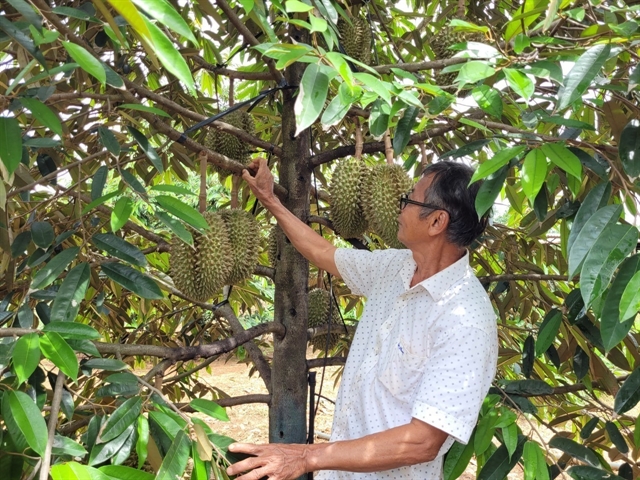Durian to make breakthrough for Việt Nam's fruit exports
The export of Vietnamese durian to China through the official channel since September 2022 opened up a new prospect for Việt Nam's fruit and vegetable industry.
 |
|
A durian farm in the southern province of Bà Rịa-Vũng Tàu's Châu Đức District. VNA/VNS Photo |
HCM CITY — The export of Vietnamese durian to China through the official channel since September 2022 opened up new prospects for Việt Nam's fruit and vegetable industry.
According to statistics from the Ministry of Agriculture and Rural Development (MARD), Việt Nam has over 100,000 ha of durian with an annual output of about 1.3 million tonnes. However, only 3,000 ha (3 per cent) of the total meet standards for export to China.
The Mekong Delta province of Tiền Giang and the Central Highlands province of Đắk Lắk have the largest durian areas meeting export standards in the country.
According to the Deputy General Director of Dũng Thái Sơn Import-Export Company, Vũ Ngọc Huy, China is a large market with a strong durian consumption capacity.
The firm can export 500,000 tonnes of fresh durian per year, accounting for over one-third of the total durian output of the country, Huy said.
Lã Trần Vinh, Director of Vĩnh Khang Co-operative in Tiền Giang, said the cooperative had worked with farmers in Mekong Delta localities such as Tiền Giang, Cần Thơ, Vĩnh Long, and Bến Tre, and the Central Highlands province of Đắk Lắk to grow a total of over 100 ha of the fruit.
All durian from the localities would be provided for Chanh Thu Fruit Import-Export Group JSC to export to the Chinese market via the official channel, he said.
After China officially opened its door to durian, Vietnamese farmers would have more opportunities to develop this crop, he noted.
To promote the export of the product to this billion-strong market, Hoàng Trung, Director of the MARD’s Plant Protection Department, recommended that export enterprises and farmers must regularly update and strictly comply with regulations on quality standards, testing, quarantine, packaging, and traceability of the Chinese market.
China’s customs authorities had approved Việt Nam’s 51 farming area codes and 26 packaging facility codes that fully meet the requirements for export to the Chinese market, Trung said.
The MARD had asked authorities of southern localities to improve the quality of the durian value chain, toward meeting standards for exporting the fruit, Minister of Agriculture and Rural Development Lê Minh Hoan said.
Specialised agencies had been tasked with identifying areas where durian can be grown sustainably, while localities had been urged to have policies for boosting the connection between farmers and export enterprises, he added.








